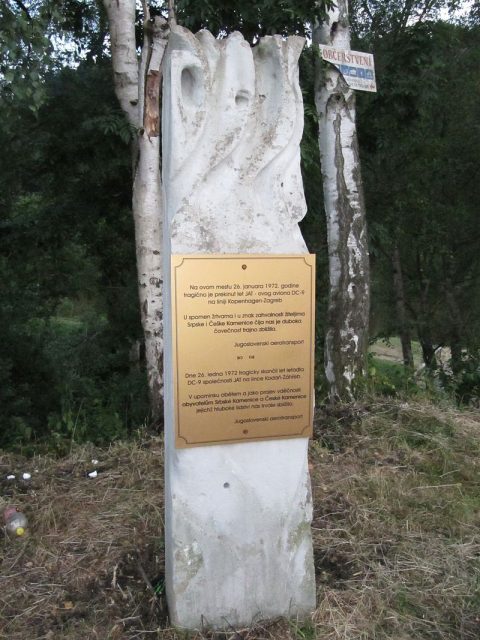There are survivors, then there is a sole survivor of a devastating plane crash. Italian master fantasist Dino Buzzati in 1966 wrote about the Ragazza Che Precipita or “The Falling Girl,” a story about Marta and her great descent from the rooftop of a gigantic skyscraper.
Buzzati masterfully used Zeno’s mathematical paradox in his narrative to slow down time as if it were not passing at all for the little girl, forcing her to contemplate her life. Many say that when people are in a state of emergency and faced with grave danger, time moves very slowly for them as well. In truth, the feeling is just an illusion and our brains are simply working faster on such occasions.
That being said, who knows how fast was it going for Vesna Vulovic in 1972 and what dreams and goals she felt she would miss as she was descending, not from a tall skyscraper, but while stuck within an airplane that burst into flames 33,000 feet up and falling ablaze, quickly accelerating towards the inevitable crash that was getting closer and closer with every passing second.
Was she thinking about all the things she would never have a chance to have? Was she thinking about her parents, about her loved ones? About everything she was about to lose. Of kids perhaps? She was 22.
All memory of the plane crash stayed forever suppressed as fragments tucked away in a far corner of her brain–a brain that luckily survived intact after her skull was completely shattered along with both of her legs, two vertebrae bones, her whole pelvis, and several ribs. She was smashed, shattered, and broken all over, yet she survived and miraculously recovered. She had no memory of what went wrong or what happened on the way down. Nor of what she was doing the whole time. Remarkably, she asked to be reinstated in her old position as a flight attendant.
Vulovic was working on board the McDonnell Douglas DC-9-32 aircraft, Flight 367 for JAT Yugoslav Airlines, that exploded mid-air and split into two over Czechoslovakia. She was not even supposed to be on the plane. She had had a day off but was mixed up with another flight attendant with the same name and was called by mistake. An hour into the flight, as they were headed from Stockholm to Belgrade, a bomb went off in the cargo hold. Twenty-seven of the 28 passengers and crew members on-board died–either in the initial explosion, sucked out of the jet plane into subfreezing temperatures on the way down, or killed when they hit the snow near the border between Czechoslovakia and Germany, in the small village of Srbská Kamenice.
Roughly 250 people lived in the village that frosty day of January 6, 1972. One of them heard the helpless women screaming for help in agony. His name was Bruno Honke and he found her nearly dead with her legs visible in the plane wreckage. She was losing a lot of blood, but a rescue team arrived quickly and took her to a hospital.
“The first thing I remember is seeing my parents in the hospital. I was talking to them and asking them why they were with me,” she said to Green Light Limited, a London based security training firm who approached her for an interview in 2002, three decades after her devastating crash.
“When I saw a newspaper and read what had happened, I nearly died from the shock,” she said in the New York Times in 2008. An investigation concluded that when the bomb went off and detached the cockpit from the rest of the plane, she found herself trapped in her seat by the food cart that miraculously kept her stuck in place the whole time.

She was in a coma for a couple of weeks after the incident but fortunately for her, the snow was thick and the plane crashed in the trees of a forested hillside that probably softened the blow enough to spare her life.
Though she was paralyzed from the waist down at first, within months she made a full recovery and went on to live a normal life (with a limp though), for the next 40 years, or until December 23, 2016, when a neighbor found her dead in her apartment in Belgrade.
“I was broken and the doctors put me together again. Nobody ever expected me to live this long,” she confessed in the same interview for the New York Times.
And nobody did indeed expect her to survive the injuries. As nobody ever imagined that, right after her recovery, she would ask her employer to resume working as a flight attendant. However, JAT Yugoslav Airlines believed that putting her back up in the air could bring bad press and risk terrifying the passengers who would be with her on the same plane and would recognize her. “They didn’t want me because they didn’t want so much publicity about the accident,” she said for Green Light.
Instead, they gave her an office job, and Vesna Vulovic, who continued to travel by air, never really was seen as a threat by passengers. On the contrary. “People always want to sit next to me on the plane,” she said. After all, she was a real hero in her country and was recognized as “the woman who cheated death” throughout south-east Europe. So in a way perhaps they saw her as a lucky charm on their flights.
As of what might have happened, it is still unclear to this day. One theory states that a bomb was placed in the luggage compartment right below the cockpit during their stop-over in Copenhagen, and another one stipulates that the plane had some problems and was looking for a safe landing in Czechoslovakia but got really low, really fast–and close to a nuclear weapons storage facility and was shot down by fighter jets. However, black boxes were never recovered, no one was arrested, and nothing was ever proven.
For what is worth, Vulovic, who unintentionally holds the record for surviving the highest free fall without a parachute, and was credited in the Guinness Book of Records of 1985, made sure to live a life worth living and make every second count.
After the devastating accident, she used all her popularity and public persona to fight against injustice and the dictatorial governance in her home country, led by President Slobodan Milosevich, who later stood trial in Hague accused of war crimes, genocide, and crimes against humanity, and was labeled as the “Butcher of the Balkans.”
